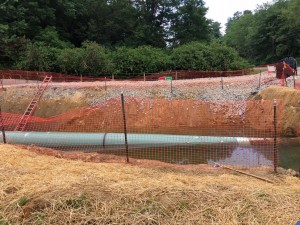From an Article by Amy Mall, National Resources Defense Council (NRDC), October 10, 2018
The massive natural gas pipelines being installed across our country are typically coated to make them safer. But coatings consist of dangerous chemicals, and they can degrade with too much exposure to sunlight or water, thereby potentially decreasing their effectiveness and creating public health risks.
Coatings reduce corrosion. Corrosion can result on the inside of a pipe due to corrosive components of the natural gas being transported. And it can result on the outside of the pipe due to components of dirt, rock, and groundwater. Corrosion degrades pipe and increases the risk of explosions.
Pipe coating reduces corrosion, but is not indestructible. It needs to be carefully applied and maintained in order to effectively prevent corrosion. The Mountain Valley and Atlantic Coast Pipelines would go from West Virginia through Virginia and on to North Carolina. In both cases, the coating being used is 3M Scotchkote Fusion Bonded Epoxy 6233. The company that is supplying the pipe for Atlantic Coast Pipeline highlights its use of the 3M coating on its website. This blog highlights two significant concerns with respect to this coating.
First, it can degrade in sunlight or with wind, rain, or other exposure to the elements.
According to a 2009 technical brief from 3M, some of the epoxy resins in fusion bonded epoxy (FBE) coatings, for example those based on diglycidyl ether of bisphenol A, “have poor ultraviolet (UV) light resistance.” A 2018 Safety Data Sheet for 3M™ Scotchkote™ 6233 lists Bisphenol A Diglycidyl Ether-Bisphenol A Copolymer among the ingredients. According to the technical brief, the coating can also be removed by wind and rain. The technical brief cites a 2000 study that recommended that pipe not be stored for longer than one year unless it is protected from UV radiation.
But according to the National Association of Pipe Coating Applicators: “Above ground storage of coated pipe in excess of 6 months without additional Ultraviolet protection is not recommended.” If the integrity of pipelines coatings is not maintained, the risks of explosions could increase.
Second, it has toxic ingredients. According to the manufacturer’s Safety Data Sheet, this 3M coating contains a chemical or chemicals which can cause birth defects or other reproductive harm, cancer, and other potential health effects.
Construction has been delayed for both MVP and ACP. During this delay, pipes have been left out in the open air much longer than originally anticipated. According to a June 2018 letter from the U.S. PipeIine and Hazardous Materials Safety Administration (PHMSA), the owner of ACP, Dominion Energy, has admitted that “…. the duration that the pipes will be stored at the pipe laydown yards will exceed the manufacturer’s recommendation.”
On January 12, 2018, in a federal court hearing, MVP’s senior vice president of engineering and construction, the “person in overall charge of the project,” stated that: “…. the epoxy coating on the outside of the pipe is the predominant barrier to assure the pipe doesn’t corrode.” He also stated that: “As it sits in the sun, it ages or oxidizes and actually becomes thinner.” He stated that “…. prior to it becoming too thin to use, you have to protect it from the sun. And so that includes either some sort of additional temporary coating, or the other thing you can do is you can restack the pipe.”
But we have no evidence that the proper inspections, monitoring, and mitigations are taking place for either pipeline.
In one known segment of the MVP pipeline route on Bent Mountain, there is very shallow groundwater that serves as the community’s drinking water source. Pipe for MVP has been observed sitting in trenches filled with what appears to be groundwater since June, as can be seen in the photo above, despite the coating containing a known carcinogen.
One study conducted for industry found that chemicals used in the coating manufacturing process may be present in the epoxy, including the solvents methyl isobutyl ketone, and ortho-, meta- and para-xylene. This study found that these solvents, which can present serious health hazards, “are quickly leached from the coating and their content may be reduced by 77% after 30 days in water.” It is unknown if other components of the coatings leach into water.
Both pipelines have stated they have an inspection process for coating. In its June letter, PHMSA reported that its staff conducted two ACP storage yard inspections in November of 2017 and concluded that there was “no evidence of degradation of the pipeline protective coating.” That was almost a year ago.
In early September, Tina Smusz, MD, a Virginia physician with a Master of Science in Public Health, wrote a letter to the Virginia State Health Commissioner and the Secretary of Health and Human Services. She requested an immediate investigation into “hazardous and potentially lethal chemicals” being released into Virginia water supplies by a number of pipeline activities, including coatings but also from other risks such as explosives, herbicides, fuel, and more.
Also in September, Virginia State Senator Creigh Deeds sent a letter to Governor Northam asking him to review the public health and safety questions surrounding pipeline coatings, and whether there are any plans to inspect the pipes before installation given these concerns.
Agencies charged with protecting human health and safety from pipeline risks, including state health departments and environmental agencies, FERC, and PHMSA, should be investigating the integrity of the coatings for both MVP and ACP pipes, determining whether remediation is needed, and halting any more pipe installation as long as more delays are on the horizon—and making all of their findings public.
>>>>>>>>>>>>>>>>>>>>>>>>>>>>>>>
See also: 3M™ Scotchkote™ Fusion-Bonded Epoxy Coating 6233 — Safety Data Sheet

